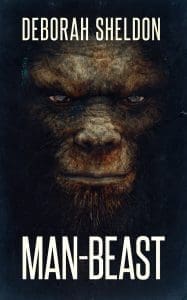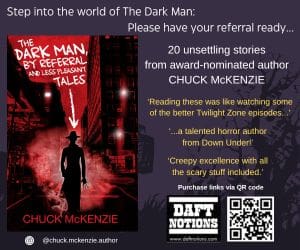10 Most Common Bigfoot Clichés
 10 Most Common Bigfoot Clichés
10 Most Common Bigfoot Clichés
Tropes abound in creature-feature fiction and films. Consumers have certain expectations, and writers who ignore those expectations risk poor reviews. But poor reviews are also in store for writers who use too many clichés. Oh, it’s a fine line, and one that I enjoy walking. My award-nominated creature-feature books include Devil Dragon, Thylacines, Contrition and Body Farm Z. I won an Australian Shadows Award for Perfect Little Stitches and Other Stories, which is packed with creatures from mermaids to harpies to aliens. Before I started writing my bigfoot novella, Man-Beast (Severed Press), I trawled the Internet for consumer opinions. What do bigfoot fans love? What do they hate? Here’s the list of over-used tropes I wanted to avoid.
Cliché 1: The story is set in North America
The sasquatch (nicknamed bigfoot) is a cryptid or legend of the US and Canada, while the yeti (a.k.a. the abominable snowman) is of the Himalayan region. Almost all ‘hairy hominid’ stories are set in these places, despite many other cultures having similar creatures in folklore. This was the easiest cliché to avoid. Since I’m an Aussie, I wanted Man-Beast to take place in Australia; specifically, ‘the outback’ which is what we call our central desert.
Cliché 2: The time is here and now
Most bigfoot stories are contemporary. Australia’s bigfoot is the yowie, a term commonly used since the 1970s. Since the mid-nineties, however, ‘Yowie’ also happens to be a Cadbury chocolate treat marketed to kids. So, I set my story in 1913, firstly to be different, and secondly to avoid the term ‘yowie’. Historical monikers for our hominid included yahoo, hairy man and Australian ape. The term that appealed to me most was Yahoo-Devil-Devil because it sounded quaintly old-fashioned – perfect for my novella’s time period.
Cliché 3: The monster is thought to be a myth
The general consensus is that the bigfoot creature isn’t real. Science puts it in the same camp as the Loch Ness Monster, faery and vampire. Giving a bigfoot story a contemporary setting usually means that characters tend to be shocked and unprepared when a flesh-and-blood sasquatch first makes its appearance. To turn this trope upside down, I made the Yahoo-Devil-Devil an accepted and dangerous Australian species like the dingo, redback spider, brown snake and crocodile.
Cliché 4: The opening chapters are mysterious
Characters are turning up dead and mutilated, yet other characters don’t know why. This trope follows on from the ‘monster is thought to be a myth’ cliché. However, there’s no mystery in the first chapters of Man-Beast. The Yahoo-Devil-Devil character – nicknamed ‘Bluey’ because of his ginger hair (yeah, that’s an Aussie affectation) – is a real animal. In fact, he’s the star attraction in Taylor’s Travelling Troupe, a circus of bare-knuckle boxers that tours agricultural shows around the country.
Cliché 5: Most characters are chaff
Bigfoot fans expect a grisly body count. That comes with the subgenre, which has a lot in common with ‘slasher’ stories like the Friday the Thirteenth movie franchise. But one complaint I saw, again and again, is that characters are introduced merely to be torn to shreds. Without any emotional connection to a character, who cares? To counter this, I invested craft and love into each of my characters to make sure that any threat, injury or death would mean something to the reader. (I often had to force myself to harm characters. After spending weeks and months living with them, I cared a great deal.)
Cliché 6: There’s only one monster
Think of the films King Kong, Godzilla, The Thing, Alien, Predator, Terminator – all of them feature one monster that wreaks havoc. It’s often the same within the bigfoot genre. Instead, I wanted to create a hominid that is as commonly Australian as the platypus. My Yahoo-Devil-Devil has a clan, much like gorillas or chimpanzees, so I had to create a species with a social system including hierarchy, body language, vocalisations and behaviour. This was not only intense, but loads of fun.
Cliché 7: The monster is always terrifying
Creature-feature movies and stories often reduce the monster to little more than a mindless killing machine. Jaws is a good example of this. From the get-go, I decided against having a one-dimensional villain; my Yahoo-Devil-Devil and his clan would be characters in their own right, with different traits and personalities. In some scenes, yes, my monsters are terrifying – after all, Man-Beast is a horror novella. In other scenes, however, they are relatable. And, dare I say it, even likeable. Lovable? Well, I’ll let the readers decide.
Cliché 8: Hunger is the motivation
Bigfoot is hungry and on the prowl for human meat! I chose a different tack: a juvenile Yahoo-Devil-Devil is captured by a travelling boxing troupe that uses him – caged and chained – as a drawcard. When his family finds him at last, revenge is their motivating factor. A factor that, I believe, most readers would sympathise with and understand.
Cliché 9: Cops, reporters and rangers, oh my!
Man-Beast doesn’t have characters from typical ‘bigfoot’ professions. My characters are boxers, promoters, mechanics, cooks, drovers and farmers. There are no modern weapons. The single-shot Martini-Henry rifle was the most common firearm in Australia circa 1913, and most of my characters aren’t familiar with it. Nor with the motor car, for that matter. Technology is simple, and communication over vast distances impossible.
Cliché 10: Gore for gore’s sake
Everyone who enjoys bigfoot films and fiction expects a certain degree of gore. That’s a given. But when scene after scene is heavy on blood, the audience can be numbed from sheer repetition. This was one of the central challenges of writing Man-Beast: to present gory scenes in a range of ways that would hit the reader differently each time. Some scenes I wrote for shock value. Others for pathos. The rest I strung somewhere between those two extremes. An author never wants the reader to guess what will happen, and I did my best to keep the surprises coming.
***
 NOVELLA BLURB:
NOVELLA BLURB:
Taylor’s Travelling Troupe of boxers has set up its tent at an isolated sheep station: bored farmers always bet to excess. Headlining the bare-knuckle fighters is Bluey, marketed as ‘The Man-Beast’, a Sasquatch-like monster, chained and kept drunk enough to fight punters without killing them. But the troupe has returned to where Bluey was first captured. Recognising the mountains, he calls again and again. And when his call is answered, all hell breaks loose.
NOVELLA URL: https://www.amazon.com/Man-Beast-Deborah-Sheldon-ebook/dp/B09FP3F95R/
AUTHOR BIO:
Deborah Sheldon is an award-winning author from Melbourne, Australia. She writes short stories, novellas and novels across the darker spectrum of horror, crime and noir.
Her award-nominated titles include the novels Body Farm Z, Contrition and Devil Dragon; the novella Thylacines; and the collection Figments and Fragments: Dark Stories. Her collection Perfect Little Stitches and Other Stories won the Australian Shadows ‘Best Collected Work’ Award, was shortlisted for an Aurealis Award and longlisted for a Bram Stoker.
Deb’s short fiction has appeared in many well-respected magazines such as Aurealis, Midnight Echo, Andromeda Spaceways, and Dimension6. Her fiction has also been shortlisted for numerous Australian Shadows Awards and Aurealis Awards, and included in various ‘best of’ anthologies such as Year’s Best Hardcore Horror.
As editor of the 2019 edition of Midnight Echo, Deb won the Australian Shadows ‘Best Edited Work’ Award. Other credits include TV scripts such as Neighbours, feature articles for national magazines, non-fiction books with Reed Books and Random House, stage plays and award-winning medical writing. Visit Deb at http://deborahsheldon.wordpress.com
AMAZON AUTHOR URL: https://www.amazon.com/~/e/B0035MWQ98
- About the Author
- Latest Posts
The Horror Tree is a resource for horror authors which was created in 2011. The main goal when starting the site was to include all of the latest horror anthologies and publishers that are taking paying submissions. A resource useful for both new and experienced publishers alike looking for an outlet for their written material!

 Deborah Sheldon is an award-winning author from Melbourne, Australia. She writes short stories, novellas and novels across the darker spectrum of horror, crime and noir.
Deborah Sheldon is an award-winning author from Melbourne, Australia. She writes short stories, novellas and novels across the darker spectrum of horror, crime and noir.










This sounds awesome. Definitely checking it out.